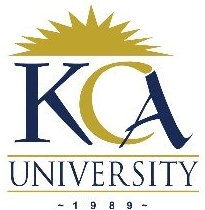
UNIVERSITY EXAMINATIONS: 2018/2019
EXAMINATION FOR THE DIPLOMA IN INFORMATION TECHNOLOGY
CIT102 FOUNDATION PHYSICS AND ELECTRICITY
DATE: APRIL, 2019 TIME: 2 HOURS
INSTRUCTIONS: Answer Question 1 AND any other TWO questions.
QUESTION ONE (COMPULSORY)
a) Define the following terms [6 Marks]
(i) Physics
(ii) Current
(iii) potential energy
(iv) wave
(v) work
(vi) acceleration
b) Briefly describe the following types of waves [4 Marks]
(i) Matter waves
(ii) Mechanical waves
(iii) Electromagnetic waves
(iv) Transverse waves
c) Briefly kinetic energy and give the expression [2 Marks]
d) Give the components of an electric circuit. Use a neat diagram in addition. [4 Marks]
e) An electron with an initial velocity v=1.50×105 m/s enters a region of length L=1.00cm,
Accelerating region. It emerges with a velocity v=5.70x106m/s. What is its acceleration
[4 Marks]
f) A key falls from a bridge that is 45 m above the water. It falls directly into a model boat,
moving with constant velocity, that is 12 m from the point of impact when the key is released.
What is the speed of the boat?
[4 Marks]
g) Give four quantities and their SI unit of measure [2 Marks]
h) State Ohms Law [2 Marks]
i) Work out the current through a 8.1KOhm resistor if a 3.7v source is connected [2 Marks]
QUESTION TWO
a) The brakes on your car can slow you at a rate of 5.2 m/s2
. If you are going 127 km/h and
suddenly apply the brakes, after how long will you reduce the speed to 100Km/h [4 Marks]
b) Give the units of measure of voltage, current, energy and power [4 Marks]
c) State any two laws of motion by Newton and for each give the application [4 Marks]
d) Name and give the use of any two measurement instruments used in electronics [4 Marks]
e) Explain the difference between constant velocity and constant acceleration motion. For each
give the formula for getting displacement (d) [4 Marks]
QUESTION THREE
a) Use atomic theory to describe what an electric current is. Use neat diagrams [6 Marks]
b) Differentiate between the following electricity concepts [4 Marks]
(i) Protons and electrons
(ii) Conductors and insulators
c) Explain the term “short circuit” and how you could detect it using a multimeter [2 Marks]
d) An electronic circuit comprises of four resistors of 30 Ω, 80Ω , 60Ω and 120Ω . The first two
are connected in series as are the next two. The two series circuits are then connected in parallel
across a 12Vd.c power source. [8 Marks]
(i) Draw the circuit
(ii) The total circuit resistance
(iii) The current from the d.c power source
(iv) The current flowing through each resistor
QUESTION FOUR
a) Briefly describe Simple Harmonic Motion using a pendulum. Include neat diagrams [6 Marks]
b) Describe the following wave properties. Draw a neat waveform [6 Marks]
(i) frequency
(ii) phase
(iii) amplitude
(iv) wavelength
c) Describe the use of EM waves in IT [4 Marks]
d) The speed of electromagnetic waves (which include visible light, radio, and x rays) in vacuum is
3.0×108 m/s. Calculate [4 Marks]
(i) Frequency of visible red light id the wavelength is 700nm
(ii) The period of the red light
QUESTION FIVE
a) Differentiate between the following [4 Marks]
(i) Transverse and Longitudinal wave
(ii) Scalar and Vector quantity
b) Give the following units as derived SI units. Show your working [4 Marks]
(i) Joule
(ii) Newton
c) Name, give examples and explain the three types of electrical materials [6 Marks]
d) A computer has a blown fuse. Explain how current, voltage and resistance are affected at the
fuse.
[3 Marks]
e) Make the following conversions [3 Marks]
(i) 3457mg to Kg
(ii) 1,110,000Km/hr to m/s
(iii) 34.5×103 gcm2
/min2
to KGM2
/s2
